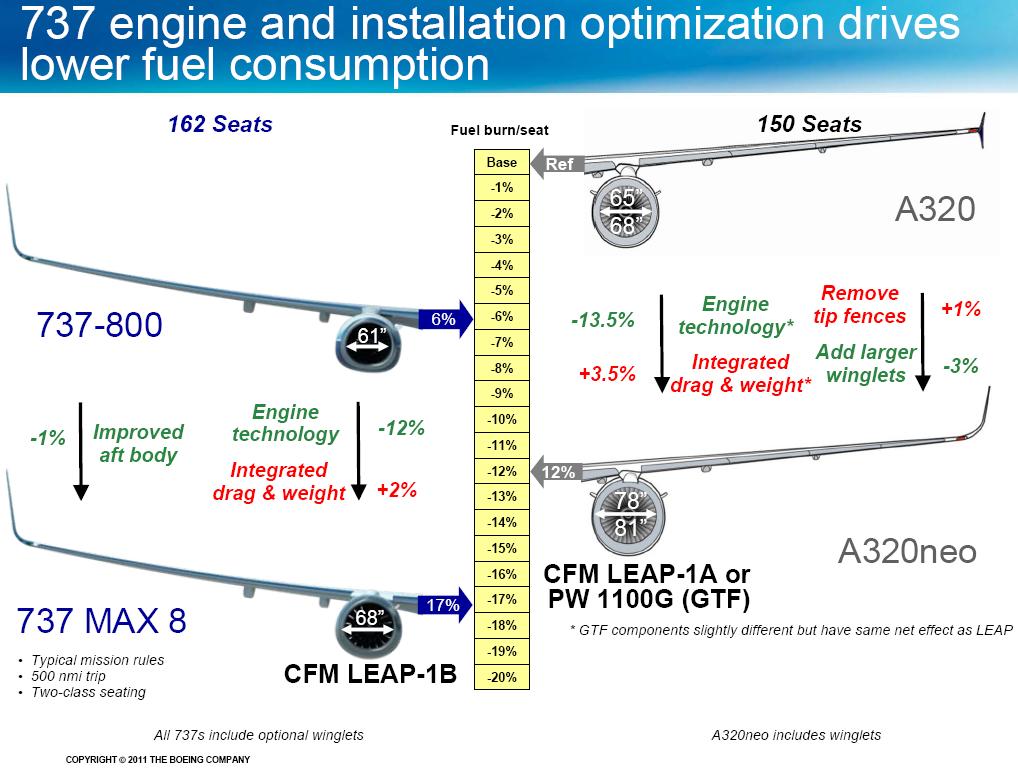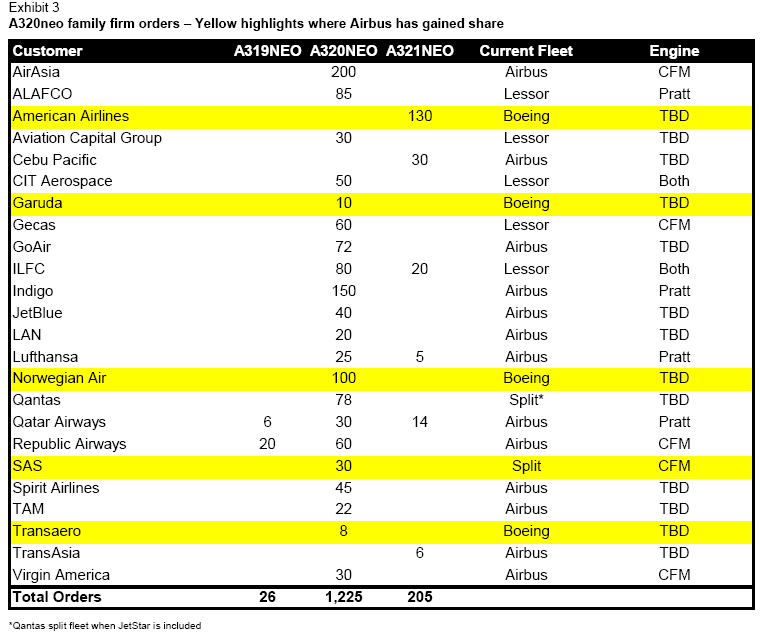Leeham News and Analysis
There's more to real news than a news release.
Airbus Neo vs Boeing MAX: customer split
Bernstein Research has a good illustration of the competition of the Airbus Neo vs the Boeing MAX. It shows which Boeing customers selected Neo
PW GTF-CFM LEAP market share
AirInsight has an interesting analysis of the market share of the GTF vs the LEAP on the A320neo family. This was completed while the Singapore Air Show was underway and orders still being announced.
The analysis only covers the neo family, where there is competition between CFM International and Pratt & Whitney. CFM is exclusive on the Boeing 737 and COMAC C919 and PW is exclusive on the Mitsubishi MRJ and the Bombardier CSeries. PW shares the engine supply position on the Irkut MS21 with a Russian powerplant.
Thus, the neo family competition provides a better snapshot of how the two engines stack up in the view of customers.
A couple of points of note for the AirInsight analysis: GECAS buys only GE engines, so PW had no chance in this exclusive-supplier scenario; and Republic’s CFM selection was part of a financial rescue package involving GECAS (which leases A319s and A320s with CFM engines to Republic subsidiary Frontier Airlines) and CFM (which restructured CFM maintenance agreements). We detailed the Republic order at the time. We also wrote this piece about how the GE powerhouse combines to win deals. The family deal with GECAS and the rescue package for Republic account for 280 of the 533 LEAP engines ordered to-date.
Separately, we’ve been provided some diagrams by CFM for publication about the LEAP and how its architecture and technology benefit from the GE90 and GEnx. These illustrations are below the jump.
Odds and Ends: Boeing market share; Airbus to Mobile, 777X v A350 and more
Boeing to gain market share: Richard Aboulafia, aerospace analyst for The Teal Group, forecast at the annual conference last week of the Pacific Northwest Aerospace Alliance that Boeing will achieve a 56% market share in the coming years. Here is the story in the Puget Sound Business Journal.
Airbus to Mobile after all? Dominic Gates reports what has been circulating for months: Airbus may open a Monile (AL) production line after all.
777X vs A350: Aspire Aviation has a long piece about Boeing’s plan for development of the 777X to meet the forthcoming competition of the Airbus A350.
Oil prices this summer: This won’t be good news for the airlines, though it should spur sales for Airbus, Boeing and Bombardier. The former CEO of Shell predicts oil will hit $120bbl this summer.
787-9 advances: Boeing is proceeding toward design definition of the 787-9, applying lessons learned from the 787-8 program.
320 Pax 787-10: Randy Tinseth, Boeing’s VP Marketing, said at the Singapore Air Show that Boeing could launch the 320-passenger 787-10 soon.
A380 cracks: Aviation Week has a close-up of the A380 cracks, with artwork that illustrates just what is what. The ever-candid Tom Enders, now the CEO of Airbus parent EADS, admitted Airbus “screwed up.”
Boeing MAX v Airbus NEO; Fan size and optimizing the LEAP for MAX, Part 2
The war of words between Airbus and Boeing continued unabated at the Pacific Northwest Aerospace Alliance 11th Annual Conference this week in suburban Seattle.
As fully expected, Airbus said its planes are better than Boeing and Boeing said its planes are better than Airbus. No news there.
But Boeing revealed a little bit more detail on the 737 MAX vs the A320 neo that suggests their analysis gives another percentage point advantage than was originally announced last August.
When MAX was announced, Boeing claimed, “The airplane’s fuel burn is expected to be 16 percent lower than our competitor’s current offering and 4 percent lower than their future offering” and “It will have the lowest operating costs in the single-aisle segment with a 7 percent advantage over the competition.” The slide shows an additional 1% advantage for fuel burn over neo and 17% over A320CEO (Current Engine Option, as Airbus now calls it), of +5 (VS 4) and +17 (vs 16). We asked Boeing about this, and we’re told the slide reflects rounding up the numbers and not an actual increase in the previously announced economic claims.
 Randy Tinseth, VP Market, showed this slide (click on the slide to enlarge), the first time we’ve seen one like it. The slide shows the improved fuel burn minus the negative impact of additional weight and drag to come up with net figures.
Randy Tinseth, VP Market, showed this slide (click on the slide to enlarge), the first time we’ve seen one like it. The slide shows the improved fuel burn minus the negative impact of additional weight and drag to come up with net figures.
What is also useful is that Boeing includes in the illustration the existing and planned fan diameters for the 737-800, the A320 and their successor airplanes. The assumptions used in the analysis are also listed on the slide.
Airbus disputes the underlying Boeing analysis as well as claiming the assumptions used favor Boeing instead of real-world operating conditions. We covered the Airbus detail following ISTAT’s European Conference in Barcelona. We sought out Boeing at that time in order to include their detail in that posting; Boeing declined. Boeing held a tele-conference November 4, but it could only be characterized as a high-level look at the program. We’ve been trying for months (since last June, in fact) to follow up their briefing in advance of the Paris Air Show and Boeing has been declining all interview requests on MAX.
CFM has likewise declined interview requests (three since August, when MAX was launched). Both companies have left the marketplace in a fog. But information obtained from customers, from Boeing and from within CFM has now painted a reasonable picture of how Boeing and CFM support their claims that the 737 MAX will be more economical than neo and how the LEAP is being optimized for MAX. In addition to the Airbus position, it should also be noted that at least one airline analysis of the MAX vs neo concludes that MAX will only be around 2% better than neo, not the 7%-8% lower operating costs claimed by Boeing.
The purpose of this post is not to attempt an independent analysis, but rather to explain why Boeing and CFM make the claims they do. This report is the result of months of talking with customers and sources within Boeing and CFM; and from public appearances by Boeing and CFM.
Optimizing LEAP for 737 MAX
There has been a great deal of debate over whether Boeing can meet the SFC reduction targets for its 737 MAX. This debate revolves in part because neither Boeing or CFM have been forthcoming about details how the CFM LEAP engine is being optimized for MAX.
We’ve obtained some details to explain how CFM is proceeding.
Details are still sketchy and hard to come by. But our source has direct knowledge of the program.
Our source compared the requirement to reduce the fan size of the 737 LEAP from 78 inches on the Airbus A320 neo to 68 1/2 inches on the MAX to the fan reduction on the GEnx from the 787 to the 747-8. The 747-8 engines are optimized for this aircraft despite the smaller fan size.
Reducing the fan enables CFM to eliminate some LPT stages, our source explains, which also cuts other parts.
This eliminations allow the LEAP to be shorter, which also allows the engine mounting to be shorter.
CFM is also using ceramics to the MAX LEAP.
These are some of the key ways CFM is optimizing LEAP for MAX.
Odds and Ends: 737 MAX development cost; another range boost for A330
737 MAX: We did this story last week on the development cost of the Boeing 737 MAX.
A330: Airbus is going to boost the range of the A330 to make it more closely match that of the Boeing 777 and 787, according to this story.
Fill ‘er up: Here’s a scary story about a goof in aerial refueling of a Boeing 707-based JSTARS.


